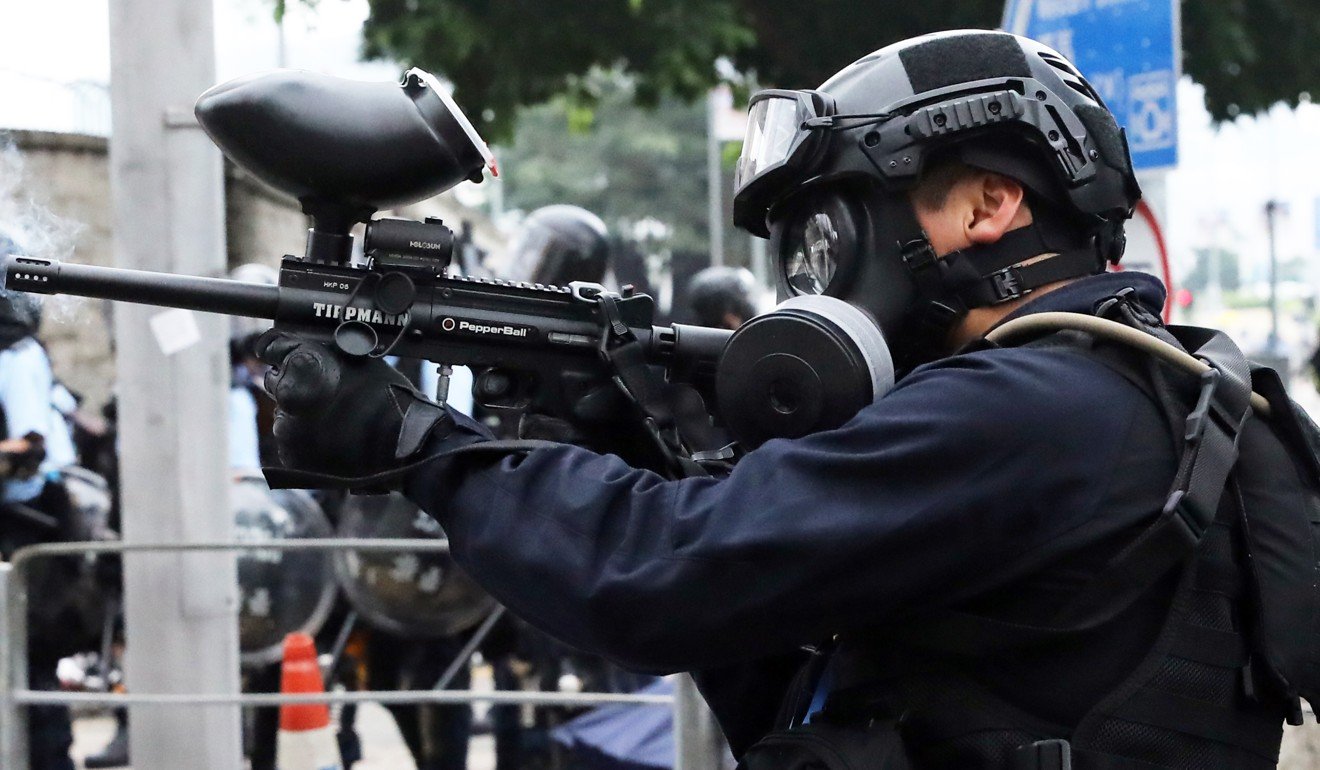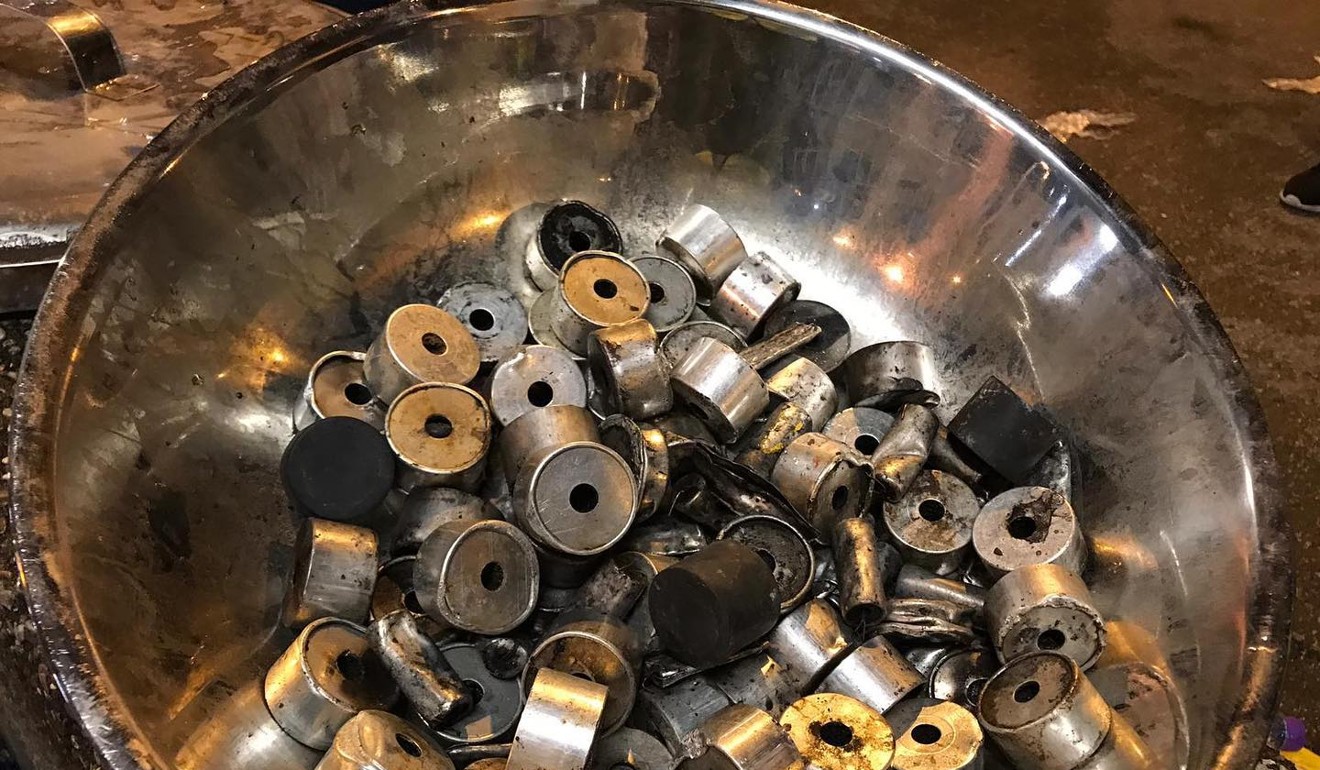
Explainer | What are the weapons Hong Kong police use on anti-government protesters, and how dangerous are they?
- Police have used crowd control methods involving tear gas, pepper spray and beanbag rounds in previous protests in the city
- But other weapons – such as pepper balls, sponge grenades or rubber bullets – were used for the first time to disperse crowds during extradition bill protests
As the social unrest over the now-abandoned extradition bill continues to rock Hong Kong, escalating tension has led to violent clashes between anti-government protesters and police.
The force has used a mix of crowd control weapons to disperse people.
Some riot weapons were used in earlier protests while others were introduced for the first time with effects and power little known to the public.
There are no legal provisions that authorise the specific use of non-lethal weapons by law enforcement agents in Hong Kong. According to the Public Order Ordinance, police may consider it necessary or expedient to use such force to disperse crowds, if “[an officer] reasonably believes that the gathering is likely to cause or lead to a breach of peace”.
It also states that police officers shall display warning flags to targeted people before using crowd control methods.
This week’s explainer discusses some of the weapons used by officers and examines their specifications, effectiveness and dangers.
Pepper spray
Similar to tear gas, pepper spray is a non-lethal chemical agent that irritates the eyes to cause tears, pain, and temporary blindness, which helps officers subdue people.
The active ingredient in pepper spray is an extraction of chilli pepper, formally called oleoresin capsicum (OC). That is why pepper spray is also called OC spray or OC foam.
It also causes the nose, throat and lungs to become inflamed and swollen immediately, which leads to gagging, coughing and shortness of breath.
Inhalation of pepper spray does not pose a significant risk to breathing and lung functions, but results in a small increase in blood pressure, according to a 2001 medical study by the University of California-San Diego. Four metres is the maximum distance pepper spray can travel once fired.

Pepper balls
Pepper balls, also called pepper-spray projectiles, can be fired from guns. The frangible projectiles break into tiny particles upon hitting a target. When each projectile breaks apart, it disperses the contained irritant payload, causing temporary blindness – just as pepper spray does. This is usually in the form of powder, but other forms include liquid, gas and aerosol.
The use of pepper spray is suggested when an individual is in “defensive resistance”, meaning they are trying to evade the officer’s control. The use of pepper spray or pepper balls is also suggested in response to “active aggression”, according to an instruction from the Force Procedures Manual.
Before 2019, police last used pepper spray against protesters during the pro-democracy Occupy movement of 2014. But pepper balls were used for the first time during the clashes on June 12.
Beanbag rounds
A beanbag round, also known as flexible baton round, consists of a small fabric bag filled with about 100 lead pellets, each weighing about 0.04kg. The rounds’ weight varies between manufacturers.
It is fired from a 12-gauge shotgun directly at the target, intended to disable the person without killing them.
As a non-lethal weapon, it is designed to be expelled at a slow velocity, at around 70 to 90 metres per second. The average bullet travels about 10 times faster, at 762 metres per second. When the beanbag round is fired over about 6 metres, its accuracy decreases. The maximum effective range is around 20 metres.
The projectile is sock-shaped with rounded edges, which cause minimum long-term trauma and no penetration, but still result in a muscle spasm to render a target immobile.
The beanbag round should only be fired at the subject’s major muscle groups which are the arms, legs and buttocks, to increase pain but avoid lethal harm.
If the bullet is shot at the head, it can cause serious injury, breaking a person’s neck, nose or skull.
Beanbag rounds were last used in Hong Kong in 2005, to disperse South Korean protesters against a World Trade Organisation gathering.
Sponge grenades
Sponge grenades are so called because of their sponge rubber impact head. The grenade is a non-lethal projectile made of a deformable rubber head and a hard plastic back. Its bullet shape is designed to be fired from a 40mm grenade launcher, directly at a person. It causes a temporary blunt pain and trauma, according to product manufacturer Pacem Defense.
It is intended to be a direct-fire, low-hazard device. The 40mm diameter makes a sponge grenade unlikely to penetrate the human body. Also, the deformed design of the rubber head reduces the risk of injury compared with other stiff rounds, as the sponge enables the projectile to absorb and dissipate some energy at early stages of the impact, according to an academic journal about impact measurements of various 40mm non-lethal sponge grenades.
The engagement range is between 10 metres and 37 metres. Being hit by a sponge grenade from within 10 metres would cause severe injury or even death.
Sponge grenades were publicly mentioned for riot control for the first time in July, when 24 sponge grenades were used during the clash with extradition bill protesters in Sheung Wan. They were also used in the Yuen Long protest on July 27 and in Sheung Wan on July 28.

Rubber bullets
Rubber bullets, properly known as rubber baton rounds, are made of rubber and plastic, fired from riot guns. Compared with sponge grenades, rubber bullets are more lethal, since they are harder and smaller. Still, the rubber bullet is considered a non-lethal method of crowd control as its shape and materials contained are designed to reduce speed and power when shot. It causes physical pain.
During the extradition bill unrest, police used two types of bullet – the 1202 rubber rocket and the MP-4-R3 Hard Rubber Batons.
The orange-coloured rubber rocket is a single-projectile round made in the US, with an effective range of 50 to 60 metres. It can produce blunt pain and trauma, according to its producer AMTEC Less-Lethal Systems.
Two months on, what do Hong Kong’s extradition bill protesters really want?
Rubber rockets were introduced during the violent clashes between police and protesters on June 12. The force is yet to release figures on how many bullets were used.
Another stronger type of bullet was first publicly mentioned at the Yuen Long and Sheung Wan protests in late July. The hard rubber baton is made in Britain, with an effective range of 50 to 75 metres. Its triple-projectile round may cause serious injury or even death if shot directly at someone from close range, according to manufacturer Non Lethal Technologies.
The bullets should only target the lower limbs, as an improperly shot bullet could kill or seriously injure its target.

Tear gas
Tear gas irritates nerves in the eyes to cause a burning sensation and tearing. It is formally known as lachrymator, an irritant chemical weapon that causes acute eye and respiratory pain, skin irritation, bleeding, temporary blindness, disorientation, dizziness and restricted breathing.
The purposes for police to use tear gas include “to deal with crowds that may cause a dangerous situation, or to stop and prevent further charging by crowds at police cordons to ensure public safety, restore social order and avoid injuries”, according to former secretary for security Lai Tung-kwok’s reply in the Legislative Council in 2014.
Tear gas can be dispersed in two forms: grenades thrown by hand, or cartridges containing five submunitions fired by launchers. The medical consequences of being exposed to the gases are typically limited to minor skin inflammation, but people with pre-existing respiratory conditions, such as asthma, may need medical attention, according to an article issued in the Journal of the Royal Army Medical Corps in 2013.
As with all non-lethal weapons, there are risks of permanent injury or death when tear gas is used. The warning written on the tear gas cartridges and canisters typically states severe injury or death may result if it is fired directly at a person.

Frequent exposure to the gas increases the risk of respiratory illness.
In Hong Kong, tear gas was first deployed by police in 2005 at the World Trade Organisation protests. It was also used during the Occupy movement.

